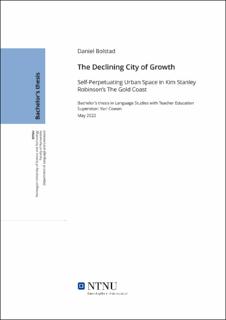| dc.contributor.advisor | Cowan, Yuri | |
| dc.contributor.author | Bolstad, Daniel | |
| dc.date.accessioned | 2022-07-16T17:20:04Z | |
| dc.date.available | 2022-07-16T17:20:04Z | |
| dc.date.issued | 2022 | |
| dc.identifier | no.ntnu:inspera:106680562:46825919 | |
| dc.identifier.uri | https://hdl.handle.net/11250/3006149 | |
| dc.description.abstract | Fordi science fiction kan fremmedgjøre virkeligheten, er den godt egnet til å utforske sosiale, kulturelle og politiske problemer, med byer som fysiske manifesteringer av disse problemene. I denne avhandlingen er byen i Kim Stanley Robinsons roman The Gold Coast fra 1988 undersøkt fra et urban-sosiologisk perspektiv. Romanen skildrer en fremtidig Orange County der økonomisk og urban vekst har vært ukontrollert. Etter hvert som offentlige rom blir erstattet med privat eiendom, forsvinner også muligheten til demokratisk deltagelse og interaksjon med en mangfoldig offentlighet. De pseudo-offentlige kjøpesentrene som erstatter offentlig rom er kontrollerte og overvåkede for å sikre at kun konsumaktiviteter tar sted; demokratiske protester er forbudt, og fattige mennesker ekskluderes. Som en konsekvens blir borgere isolert fra samfunnets realiteter, som bidrar til å skape en apolitisk og apatisk kultur. Denne kulturelle retningen hjelpes av verdier som materialisme og individualisme, som pseudo-offentlige rom kommuniserer til sine brukere, og som brukerne internaliserer. På grunn av dette etablerer erstatningen av offentlig rom med pseudo-offentlig rom en syklus som forsterker hierarkiene som drar nytte av disse verdiene, samtidig som sosial ulikhet reproduseres og offentligheten blir passiv, slik at de ikke kan motstå videre urban utvikling. | |
| dc.description.abstract | Because of science fiction’s capacity to defamiliarize, it is well-suited to explore social, cultural, and political issues, with cities acquiring a meaningful role as physicalized representations of these issues. In this paper, the role of the city in Kim Stanley Robinson’s 1988 novel The Gold Coast has been investigated from an urban sociological perspective. The novel depicts a future Orange County in which economic and urban growth has run unchecked. As public space is replaced by private development, most places where democratic participation and diverse public interaction are possible disappear. The pseudopublic malls that replace public space are controlled and policed for the purpose of consumption; democratic dissent is prohibited, and impoverished people are excluded. Consequently, citizens are isolated from the realities of their society, contributing to a culture of apathy and apoliticism. This cultural trajectory is assisted by the values of materialism and individualism which the pseudopublic space communicates to its users, and which its users internalize. For these reasons, the replacement of public land with pseudopublic space establishes a cycle which reinforces the hierarchies that benefit from these values, while reproducing social inequality and pacifying the public, making them unable to resist further urban development. | |
| dc.language | eng | |
| dc.publisher | NTNU | |
| dc.title | The Declining City of Growth: Self-Perpetuating Urban Space in Kim Stanley Robinson’s The Gold Coast | |
| dc.type | Bachelor thesis | |
